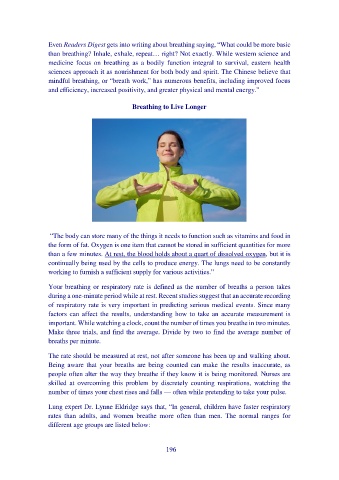Page 196 - Wasserstoff Medizin
P. 196
Even Readers Digest gets into writing about breathing saying, “What could be more basic
than breathing? Inhale, exhale, repeat… right? Not exactly. While western science and
medicine focus on breathing as a bodily function integral to survival, eastern health
sciences approach it as nourishment for both body and spirit. The Chinese believe that
mindful breathing, or “breath work,” has numerous benefits, including improved focus
and efficiency, increased positivity, and greater physical and mental energy.”
Breathing to Live Longer
“The body can store many of the things it needs to function such as vitamins and food in
the form of fat. Oxygen is one item that cannot be stored in sufficient quantities for more
than a few minutes. At rest, the blood holds about a quart of dissolved oxygen, but it is
continually being used by the cells to produce energy. The lungs need to be constantly
working to furnish a sufficient supply for various activities.”
Your breathing or respiratory rate is defined as the number of breaths a person takes
during a one-minute period while at rest. Recent studies suggest that an accurate recording
of respiratory rate is very important in predicting serious medical events. Since many
factors can affect the results, understanding how to take an accurate measurement is
important. While watching a clock, count the number of times you breathe in two minutes.
Make three trials, and find the average. Divide by two to find the average number of
breaths per minute.
The rate should be measured at rest, not after someone has been up and walking about.
Being aware that your breaths are being counted can make the results inaccurate, as
people often alter the way they breathe if they know it is being monitored. Nurses are
skilled at overcoming this problem by discretely counting respirations, watching the
number of times your chest rises and falls — often while pretending to take your pulse.
Lung expert Dr. Lynne Eldridge says that, “In general, children have faster respiratory
rates than adults, and women breathe more often than men. The normal ranges for
different age groups are listed below:
196

